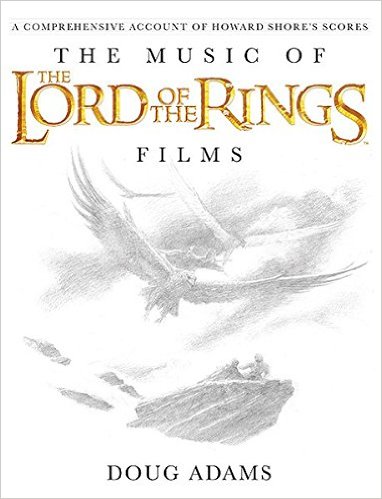The Music of The Lord of the Rings Films

The Music of The Lord of the Rings Films: A Comprehensive Account of Howard Shore’s Scores. Doug Adams. ill. John Howe and Alan Lee. Carpentier, 2010. xiii + 401 pp. $59.95 (Hardcover). ISBN: 978-0-7390-7157-1.
Reviewed by Bethany Waugh
[This review originally appeared in Mythprint 48:2 (#343) in February 2011.]
This book is everything it claims to be. It is a comprehensive account of Howard Shore’s scores, made accessible to the world. Adams has very skillfully written this ultimate tribute to Howard Shore and the magnificent music he composed for Peter Jackson’s movie adaptations of The Lord of the Rings.
The book begins with introductions from both Howard Shore and Fran Walsh, who themselves have been involved with this book, which has taken a monumental ten years to actually reach completion. Throughout its pages, The Music of The Lord of the Rings Films takes readers on a journey through Middle-earth. A journey seen through the eyes of a sub-creator, a master composer, seeing Tolkien’s world through music.
The first section is devoted to an in-depth study of Shore’s ninety main musical themes for the films. Adams shows his skills as he gives complete explanations of not only the reason for the themes but of the musical theory used in them. He provides an “In Theory” section for each theme, which shows the various musical connections between motifs, and the way the whole score is linked together. Each page is interwoven with beautiful full-color photos, or sketches and concept art from the films, which make reading this book a pleasure.
The second section is an expanded version of the “Annotated Scores” which first appeared online with the complete recordings soundtracks of the films. The book does somewhat presume the reader to have seen the extended version of the films or heard the complete recordings. This section gives a complete overview of every scene from the three Lord of the Rings movies, concentrating on the musical storytelling and interpretation of each moment. Various quotes from Shore give the reader insight into why he used a particular instrument, what emotion he was trying to achieve, and what themes he was skillfully weaving into each and every scene. The verses for each choral piece are given both in their original language (including Old English, Sindarin, Quenya, Adûnaic, Khuzdul, and the Black Speech) and in English, throughout each scene description. For musicians, like myself, the real treasure in this book is to be found in the constant musical examples which appear in every section, area, and chapter, showing in notation all the themes, motifs, and orchestrations which make up the very soul of the music. Alongside these, Adams has also catered to the everyday reader, explaining all musical terms in footnotes where needed.
To finish the journey of this marvelous book, there is a section about the recording sessions. It’s full of very interesting material, and not to be missed. Many notes about the vocalists and musicians leave the reader with insights into the world of professional scoring, accompanied with floor plans showing how Shore arranged his orchestra. This section says a lot about Howard Shore and how hard he worked on these wonderful scores.
The rarities archive is a beautiful accompaniment to the book and contains many lovely pieces of music which haven’t been heard before, as well as an interview with Shore, where he mentions the upcoming film project, The Hobbit, all the while explaining how he put together his masterpieces. In conclusion, this book is both informative and interesting with brilliant attention to detail and quality. Doug Adams has written a masterpiece of his own, both scholarly and entertaining and I have nothing but praise for this book.

